Shopify Review: A Good Ecommerce Platform for 2025?
Shopify is the most popular ecommerce platform in the world. The tool is the best choice for many online store owners, but there are also a few good reasons not to use it. Read this Shopify review to find out if the platform is a good fit for your ecommerce project.
Shopify review overview
Our score:
4 / 5
Shopify pros
Shopify cons
The ecommerce platform you choose can make or break your online store. That's why it's extremely important to select the tool that perfectly aligns with your needs and preferences.
There are countless ways to run an online store, and Shopify is the most well-known. It's a platform I've personally used for various projects. I consider it one of the best platforms for running an online shop. However, it's far from the only option, and it might not necessarily be the best solution for you.
You'll find out exactly how this works and much more in this in-depth Shopify review.
What is Shopify?
Shopify is an all-in-one, closed ecommerce platform that provides you with all the tools you need to set up an online store without any technical knowledge.
You can add as many products to your Shopify store as you want, and you can manage payments, shipping, and your shop's design all from a single dashboard. You don't need to worry about setting up web hosting or registering a domain name with a third party.
You can manage everything from a single platform.
Millions of Shopify sites are online, and since October 2021, the platform has been used by more than 1,750,000 online retailers. The platform has existed since 2006 and has since become the most dominant ecommerce platform in the world.
Shopify is used both by people who run an online store as a “side hustle” and perhaps earn a few hundred euros per month, as well as by large enterprises that generate millions in revenue each year. Among the big names using Shopify are General Electric, Tesla, and Amnesty International.
Setting up an online store with Shopify
Setting up an online store with Shopify (choosing a design, customizing text, adding your first products, and selecting payment methods) shouldn't take more than a few hours.
It's a relatively straightforward process that mostly speaks for itself.
Themes
Shopify themes determine the look and feel of your online store. Shopify offers six free themes.
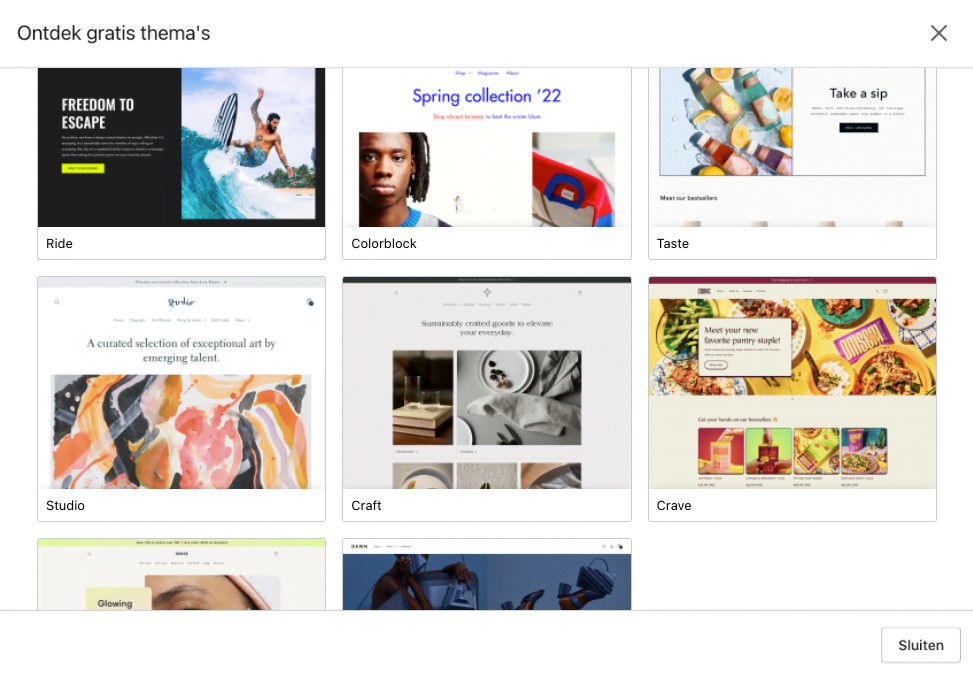
Additionally, there are countless themes available in the Shopify app store. For the vast majority of these themes, you'll need to pay. The prices are quite substantial: expect to pay between $150 and $350.
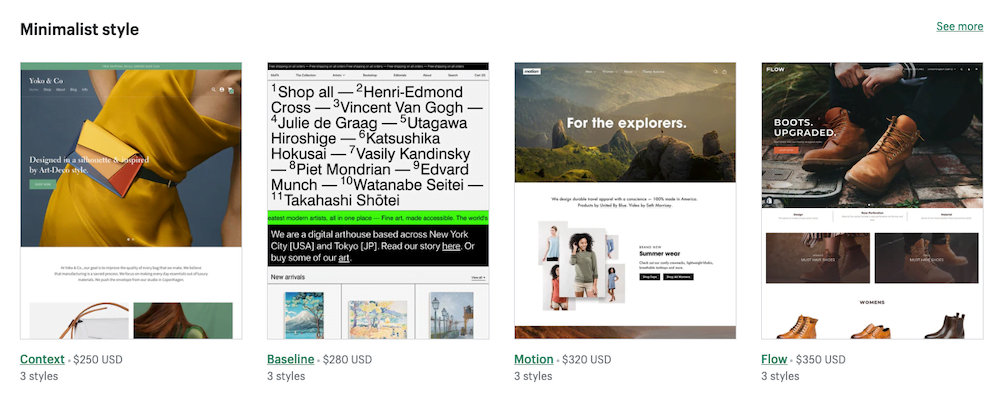
Shopify's free themes all look beautiful and polished, but it's unfortunate that the selection is limited. You would expect a platform of Shopify's size to offer dozens of free options.
This means you'll likely find that the free options don't quite match what your shop needs, and you might need to spend a few hundred dollars on a premium theme.
Site editor and adding products
Shopify has an easy-to-use Site Editor where you can customize your homepage according to your preferences. You can add text blocks, adjust images, and change the order of certain elements with just a few clicks.

Don't expect as much freedom as you'd get with WordPress or a tool like Wix, but you can still go quite far in designing a unique layout for your site.
Adding products isn't much more difficult. Choose a name, add a description and some images, and set a price.
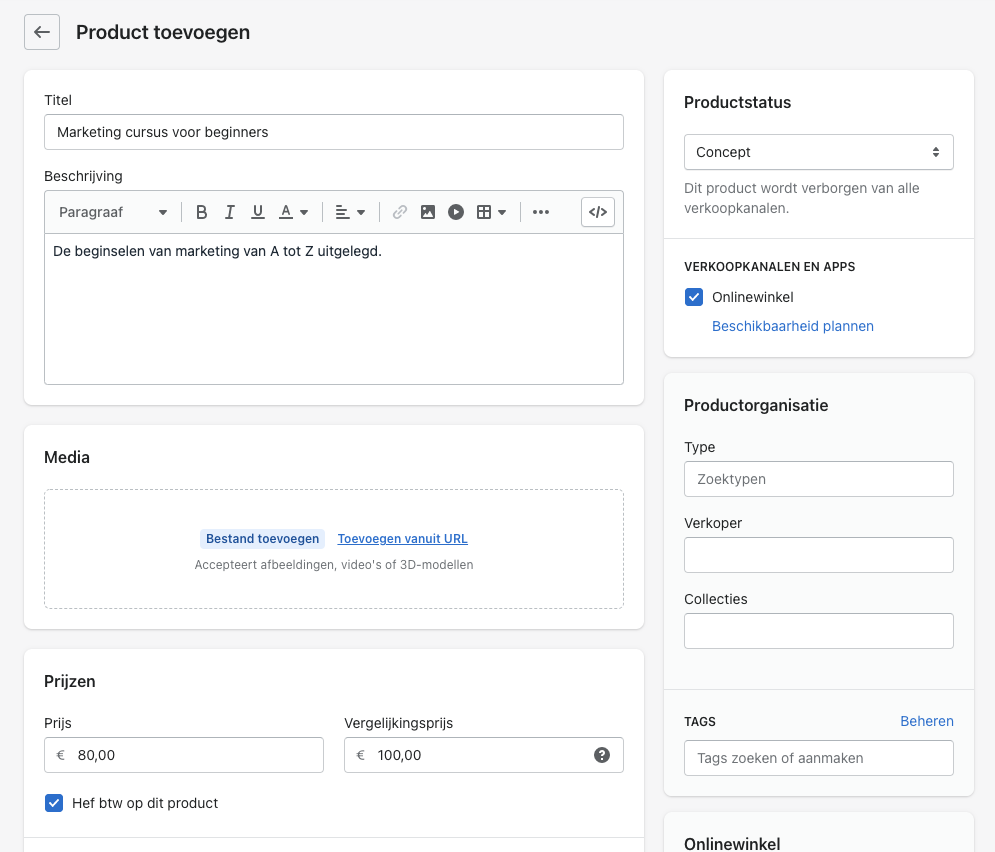
All of this works as intuitively as you would hope, with a minimal learning curve.
Blogging feature
You can easily add blog posts with Shopify.
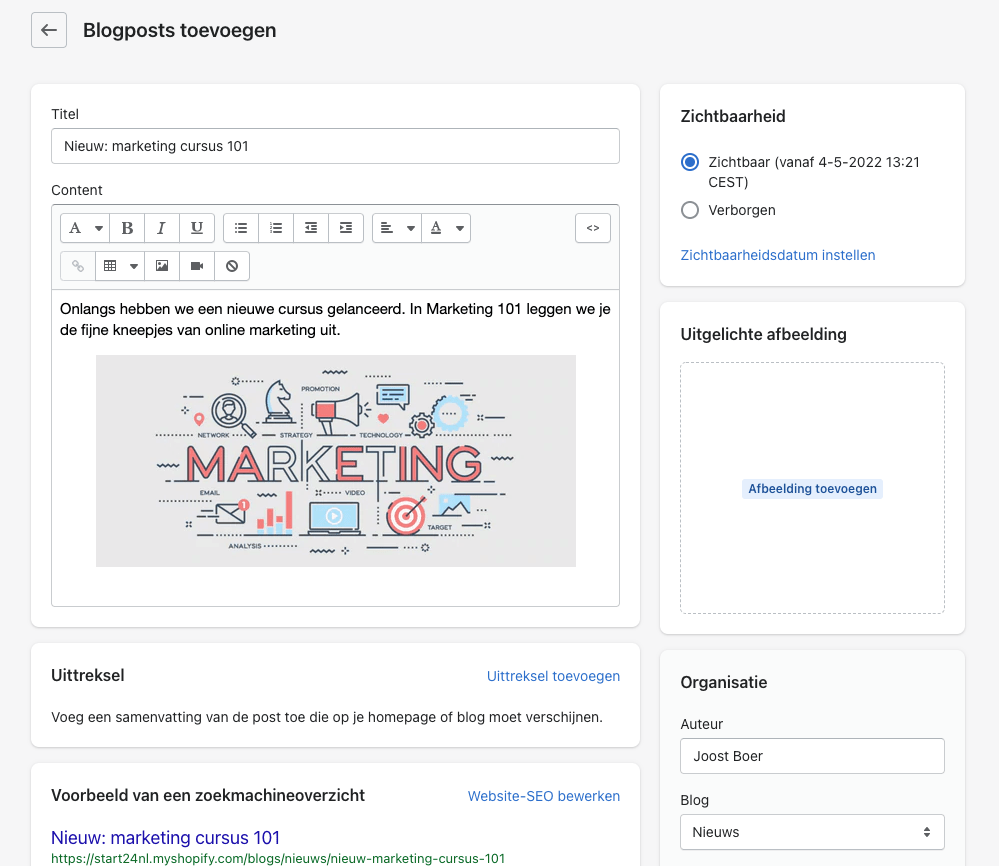
Compared to a platform like WordPress, this functionality feels quite stripped down. This is something to consider if you were planning to rely heavily on organic traffic through content marketing.
If that's the case, you might be better off using WooCommerce in combination with WordPress, or using Shopify Lite on your WordPress site.
Shopify's most interesting features
Shopify offers an impressive array of features that make running an online store much more profitable and straightforward. Here are some examples.
- Send an automatic email to potential customers who have abandoned their shopping cart
- Offers free shipping above a certain order value
- Easily translate your online store into 50+ languages
- Flexible shipping costs based on weight and location
- Easy-to-use discount codes that your customers can enter at checkout
- Segment your visitors using customer profiles
- Social media integration: add features like a “shop” button to your Facebook page
- Access to Shopify Experts who can help with design, technical aspects, marketing, and more
Payment methods
Shopify supports dozens of payment methods. The built-in Shopify Payments is the best option and allows you to accept payments through iDeal, Visa, MasterCard, Apple Pay, and more. Using Shopify Payments gives you the lowest transaction fees.
In addition to using Shopify Payments, you can also accept payments through other methods such as:
- 2Checkout
- Adyen
- Alipay
- Amazon Pay
- Braintree
- Coinbase Commerce
- WeChat Pay
The Shopify app store
The Shopify App Store provides access to thousands of free and paid apps that you can use to add extra functionality to your store.
Take the DPD app as an example. If you want to offer DPD as a shipping method, you can use this app to send tracking codes to your customers and print labels for your plans.
But there are also apps for product reviews, landing page builders, and much more.
Shopify customer support
Shopify has one of the better customer support services in the industry.
Shopify customer support is available 24/7 via phone, live chat, and email. This applies to all their plans, although phone support isn't available with the Lite plan.
Additionally, Shopify offers an extensive knowledge base, a forum, and a YouTube channel.
There are plenty of channels available to solve your problems.
How secure is Shopify?
When you own an ecommerce shop, security is a much more important issue than when you're running, say, a blog. You'll be handling your customers' payment information, their address details, your sales records, and other sensitive data.
As the world's largest ecommerce platform, Shopify is certainly aware of this. Shopify is PCI compliant (to be precise, Level 1 PCI DSS compliant), so you don't have to worry about payment details and other business data.
In practice, this means that:
- You are on a fully secured network
- Your customers' payment information will be protected
- Vulnerabilities are continuously monitored
- Strong access controls are in place (preventing hackers from easily gaining brute force access to your shop)
- The network is regularly checked and tested
- An information security policy is maintained and enforced
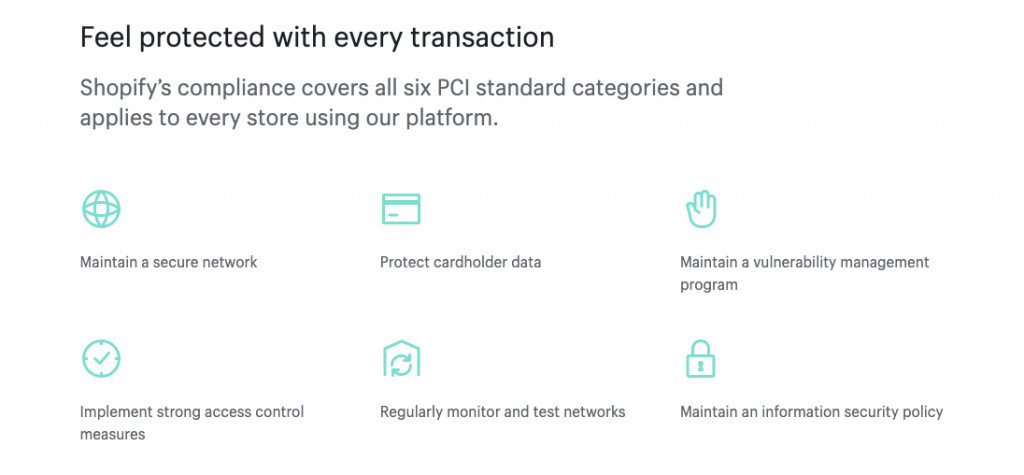
Every online store that uses Shopify is automatically PCI compliant. You don't need to take any additional measures yourself.
In addition to security, uptime is also crucial for online stores. If your webshop goes offline, it's equivalent to a closed physical store. You can't sell anything. Your customers will look elsewhere for what they need, and you'll miss out on revenue.
Shopify offers an uptime guarantee of 99.98%. Additionally, Shopify creates backups of your store and provides access to these backups whenever you need them. They also automatically add an SSL certificate to your website.
In short, you don't need to worry about security with Shopify.
How fast is a Shopify web store?
Website speed is a Google ranking factor. This means that faster sites rank higher than slower sites in Google's search engine. Additionally, fast websites convert better than slow ones. With each extra second of loading time, you increase the chance that a visitor will click away from your website, potentially causing you to miss out on sales.
For ecommerce websites, speed is always a challenge. It doesn't matter whether you're using an open source solution like WooCommerce or a closed platform like Shopify or Wix. Due to the dynamic nature of an online store, your server resources will be under significantly more pressure than with a static content site (like WebsiteGecko).
The average Shopify store doesn't score particularly well when it comes to speed. I tested the speed of roughly 10 Shopify webshops, including Allbirds.eu.
This is how the homepage of this site scored according to GTMetrix, a well-known speed testing tool that provides a 360-degree view of a website's performance:
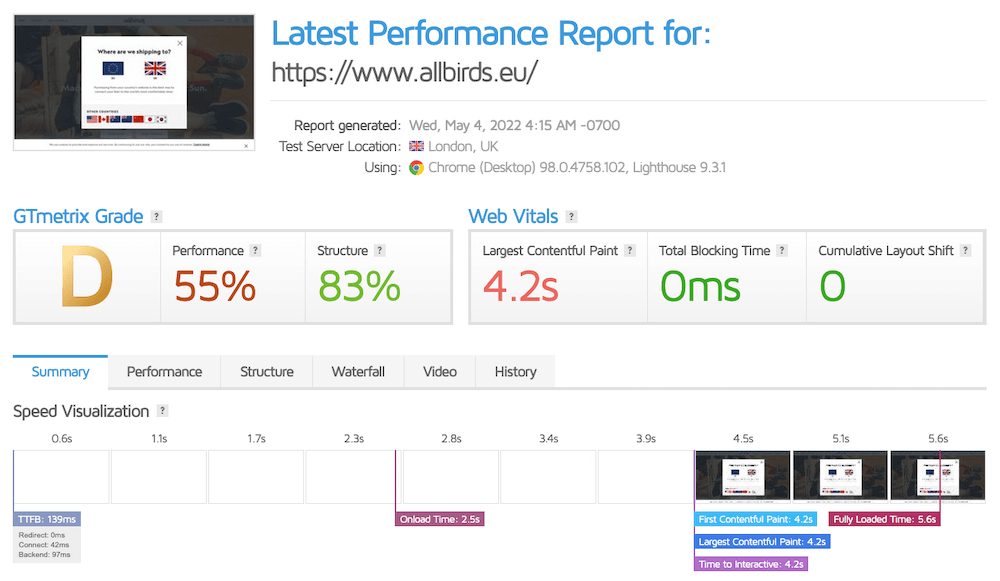
This score is far from impressive. The only metric that performs reasonably well is Time to First Byte (TTFB). This measures how quickly a page begins loading after a user requests it. According to Google, anything under 200ms in this category is considered excellent.
The website fails to pass Google's Core Web Vitals (which have been a Google ranking factor since 2021).
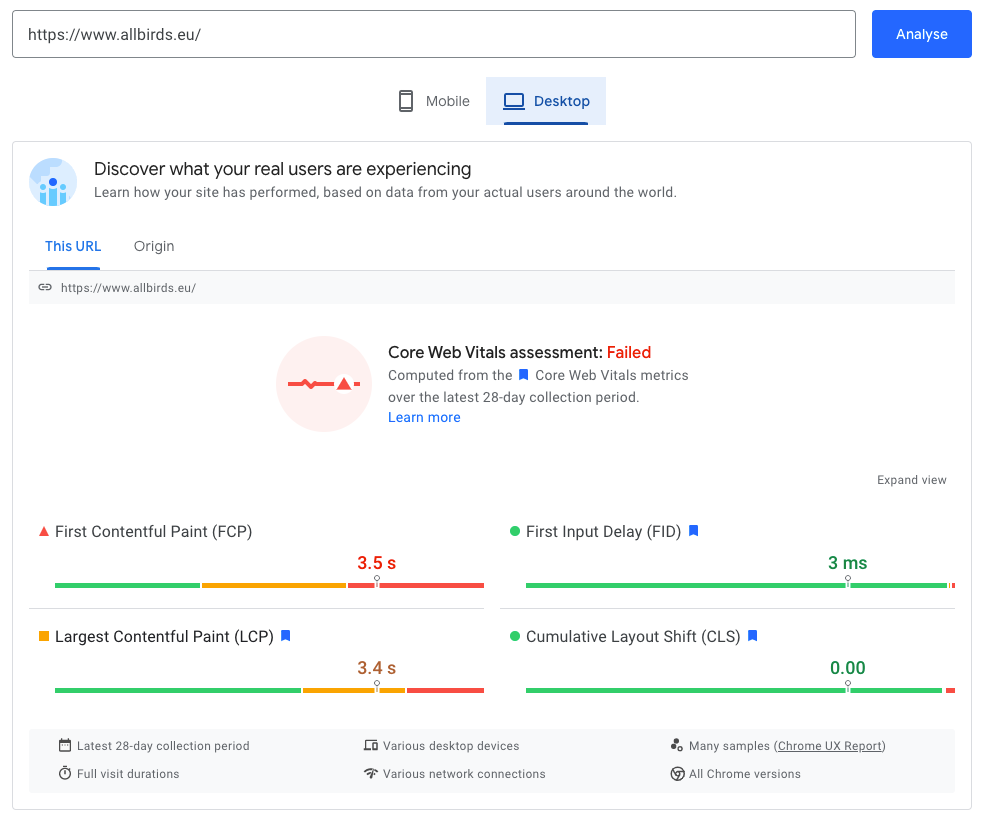
And the PageSpeed score is also deep in the red:
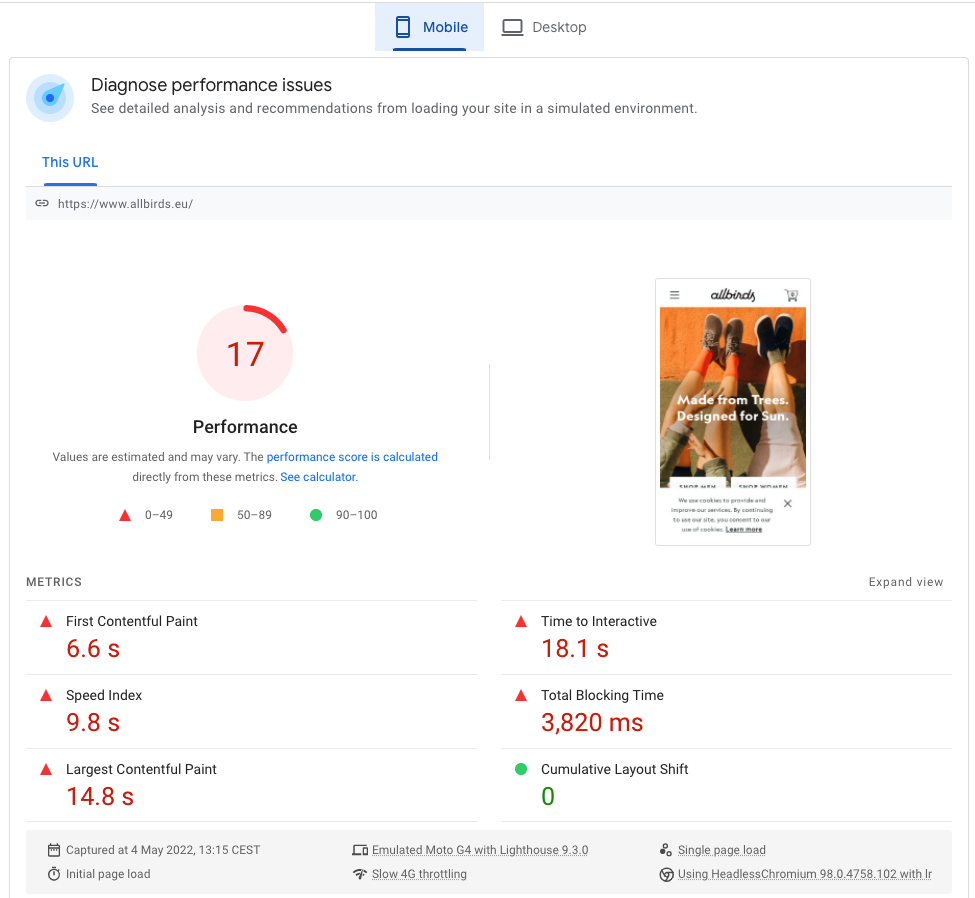
The scores of the other online stores I tested didn't perform much better. Some of these shops are enormous enterprises that (I assume) employ developers specifically focused on load times. That made these scores somewhat surprising.
How much should you worry about low speed scores from tools like PageSpeed and GTMetrix?
The good news is that Shopify is by far the most dominant ecommerce platform in the world. So even if your speed performance is suboptimal, millions of other sites are in the same boat. Website speed is ultimately a relative factor. As long as you're not below the average speed of your competitors (who often use Shopify as well), you don't need to worry too much about it.
Additionally, the average WordPress site with WooCommerce or a Wix website doesn't perform much better (unless you're paying through the nose for hosting with the former).
Shopify is ultimately a very solid platform. You can assume that their servers are among the best in the world.
Keep in mind that for an ecommerce shop, Google PageSpeed scores of around 50 and above are already acceptable. This should be achievable with a few simple adjustments.
If you want to set your Shopify store apart from competitors in terms of speed, you can make significant progress by implementing the following measures:
- Use a site like TinyPNG to compress your images before uploading them
- Use only one font
- Remove apps you don't use
- Choose one of the faster Shopify themes
Examples of Shopify online stores
Before diving into Shopify, you probably want to see examples of sites that have been built with the platform.
Below you'll find some of my personal favorites.
Partakefoods.com
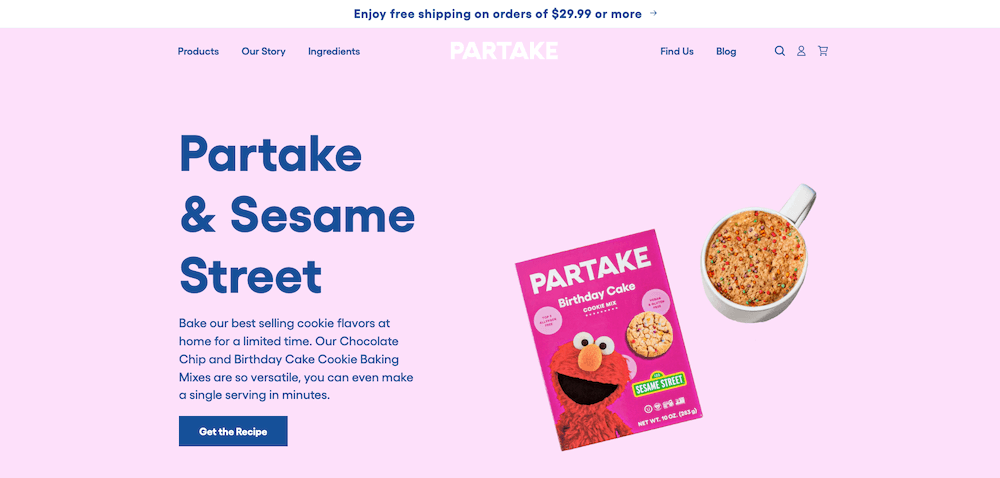
Flourist.com

Uppercasemagazine.com

Allbirds.eu

Shopify pricing & plans
There are 3 “full-featured” Shopify plans to choose from: Basic, Shopify, and Advanced. As a new online store owner, it's usually best to start with the cheapest plan and upgrade when necessary.
There's also Shopify Lite. The difference between the Lite plan and other Shopify plans is that with Lite, you can't launch a full Shopify store. Shopify Lite is designed to integrate with an existing website or social media page.
| Package | Basic | Shopify | Advanced |
|---|---|---|---|
| Pricing | $21 per month | €59 per month | €289 per month |
| Number of products | Unlimited | Unlimited | Unlimited |
| Team Members | 2 | 5 | 15 |
| 24/7 support | ✓ | ✓ | ✓ |
| Inventory Locations | Up to 4 | Up to 5 | Up to 8 |
| Reports | ✕ | Standard | Advanced |
| Ecommerce Automation | ✕ | ✕ | ✓ |
| Transaction fees without Shopify Payments | 2% | 1% | 0.5% |
| Custom Pricing by Market | ✕ | ✓ | ✓ |
In my opinion, Shopify's pricing is fair considering what you get for it.
There are definitely cheaper ways to get an online store up and running. For example, if you start an online shop with WooCommerce, it typically costs no more than $10 per month (for hosting). However, depending on your WordPress theme and plugins, you might end up spending significantly more in the long run.
With a service like Webador, you can get an online store up and running for much less money than Shopify. However, this service offers significantly fewer features than Shopify and is really only suitable for hobby-level shops or small side businesses.
Something to consider: the monthly Shopify fees aren't the only expense. There are also transaction costs per sale that can vary significantly depending on the payment method you choose.
| Basic | Shopify | Advanced | |
|---|---|---|---|
| Online European Credit Card Rates | 1.9% + €0.25 | 1.8% + €0.25 | 1.6% + €0.25 |
| International/Amex Credit Card Fees for Online Transactions | 2.9% + €0.25 | 2.8% + €0.25 | 2.6% + €0.25 |
| Bancontact Pricing | 1.9% + €0.25 | 1.8% + €0.25 | 1.6% + €0.25 |
| iDeal Pricing | 0% + €0.29 | 0% + €0.29 | 0% + €0.29 |
| Credit Card/Debit Card Processing Fees for In-Store Sales | 1.4% + €0.00 | 1.25% + €0.00 | 1.1% + €0.00 |
| Transaction fees without Shopify Payments | 2% | 1% | 0.5% |
For which type of user and online store is Shopify suitable?
If you're looking for the most comprehensive ecommerce platform for your online store, then Shopify is typically your best choice.
Shopify is ideal if you have big ambitions for your online store in terms of growth, revenue, and product range. Compared to some other solutions, it allows you to focus maximally on your core business (selling products) and minimally on the technical aspects behind it.
Shopify is suitable for both complete beginners and advanced users. There are Shopify stores that generate millions of euros in monthly revenue. At the same time, it's used by people who sell just a handful of products per month as a side hustle.
Reasons not to use Shopify
There are 2 good reasons not to use Shopify:
- Costs. Shopify is more expensive than the alternatives. If you don't need that much functionality and perhaps only want to sell a few different products, there are more sensible options.
- Flexibility and owning your online store. Just like with website builders such as Wix or Webador, you don't actually own your shop. You're renting it. You're part of a closed ecosystem, which means you're bound by certain rules. Although the chance is small, Shopify could take your store offline if you do something they don't approve of. Additionally, you can't switch hosting providers, and the options for custom code and unique functionality and design are limited.
If you're looking to keep your costs as low as possible, don't need many features, and want the most user-friendly solution available, check out Webador. You can read more about them in our detailed review.
WooCommerce is the best option if you're looking for freedom and flexibility. WooCommerce is open source and free. All you need to do is set up a WordPress website. WooCommerce and WordPress have a steeper learning curve than Shopify and require more maintenance after setting up your store (think about keeping your WordPress theme and plugins up to date). Therefore, if you want to spend as little time as possible on the technical aspects of your online store, WooCommerce isn't a good option.
If you're drawn to the freedom and flexibility of WooCommerce, take a look at our WooCommerce guide that shows you step by step how to set up an online store with it.
Shopify reviews: what do users think of it?
Shopify fares poorly on online review platforms. On a site like TrustPilot, the service scores a dismal 1.1/5 after just over 1,200 reviews (a low number considering the millions of users it has).

While I typically factor user reviews into my evaluation of online platforms, I feel that with Shopify, most online review platforms have transformed into one-sided complaint boxes, lacking balance and nuance.
Additionally, many user reviews actually focus on webshops that use the Shopify platform—not Shopify itself.
Conclusion
I hope this Shopify review has made your life a little easier when it comes to choosing an ecommerce platform.
The question ultimately isn't what type of online store is suitable for Shopify. The answer to that is “all of them.” From a small hobby shop with just a dozen products, to a mammoth store with thousands of products and millions of euros in revenue – it can all be done with Shopify.
The question isn't whether Shopify works well or not. The software is intuitive, offers all the features you need, and is easy to master.
Keep in mind, you need to consider how much ease of use matters to you compared to freedom and flexibility. With Shopify, you're operating within a closed ecosystem. You have little control over the technology powering your store. Additionally, you're bound by their rules.
Another question is about the cost. Shopify is far from cheap. If you only want to sell a few products, you can easily do this through a more budget-friendly platform.
However, the bottom line remains that Shopify is one of the most comprehensive, and in many cases, the best way to create an online store.

